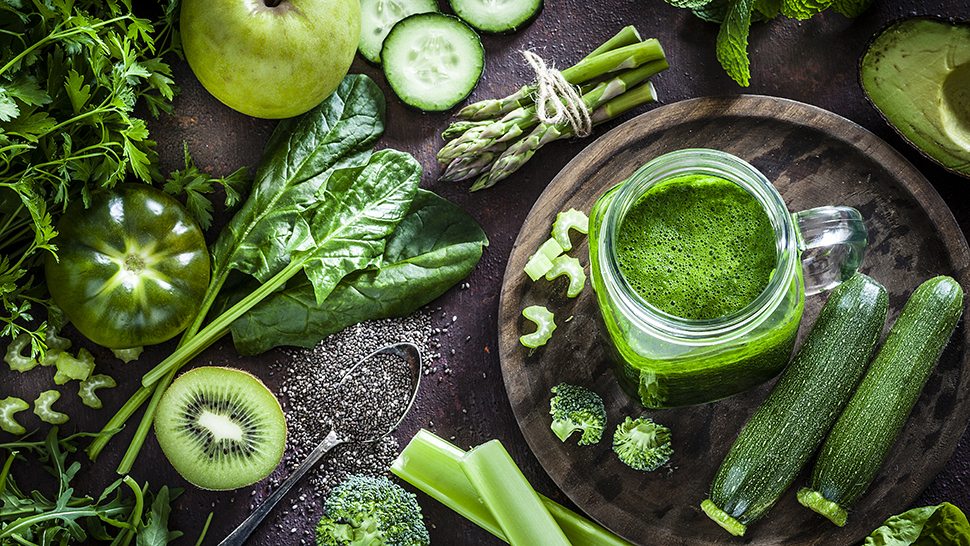
Green smoothies, green juice, and “shots” of greens are a go-to breakfast, snack, or post-workout drink for many health enthusiasts. Cold-pressed juice bars are popping up on every corner, and a quick glance at many menus suggests that by consuming blended or juiced greens you are essentially drinking a salad, so it must be good for you. Although there are some benefits to these drinks, (Just looking at a kale-filled smoothie makes you feel healthy, doesn’t it?), drinking your greens (or other vegetables) may not always be the best way to get your nutrients.
First Crush
Fresh juice is made by pressing the juice from fresh fruits and vegetables then discarding the skin and pulp. This process removes the fiber, a nutrient linked to improved digestion, lower cholesterol, and satiety (the feeling of fullness). So, while green (and other cold pressed) juices do offer a hefty dose of vitamins, minerals, and phytonutrients, you miss out on a key benefit of eating fruits and vegetables — the fiber content. Because juice is nearly 100 percent carbohydrate (lacking protein, fat, and fiber), it is quickly digested and absorbed, leaving you hungry soon after. A typical 12-ounce juice contains around 1.5 pounds of produce and ranges from 60 calories (for vegetable-heavy juices) to 200 calories (a mix of fruits and vegetables or pure fruit juice). It’s easy to down a glass of juice pretty quickly (and be hungry 30 minutes later), but imagine actually sitting down to eat a plate full of that amount of fruits and vegetables — it’d be hard to finish! So, although juice can be part of a healthy diet, it’s definitely not a meal replacement and probably not the best way to get your greens.
Smooth(ie) Operator
Smoothies, on the other hand, retain the fiber from fruits, vegetables, nuts, and seeds. So, you get the benefit of the nutrients and the fiber. Adding a protein source can help keep you full and limit blood-sugar spikes, making smoothies a good snack or on-the-go meal. Greens and other vegetables like cauliflower or zucchini are great additions, and the other ingredients (like fruit) help mask the vegetal flavors. So, it can be a good way to sneak in some extra vegetable servings, especially for picky eaters (kids included!). For both juice and smoothies, the calorie and sugar content vary depending on the ingredients (fruit adds more calories and sugar than vegetables). Avoid calorie and sugar bombs such as ice cream or flavored yogurt and beware of adding too much nut butter, oil, or seeds — it’s easy for calories to add up quickly if you aren’t careful!
Some research suggests that our bodies don’t register liquid calories in the same way we do solid calories, or that they aren’t as satisfying. However, protein may increase satiety, as can a small amount of healthy fat such as a quarter of an avocado or 1 to 2 tablespoons of flax, chia, or hemp seeds, or nut butter (choose the unsweetened kind). With that said, it’s easy to drink smoothies more quickly than eating a meal. One way to combat this is to make a thicker smoothie bowl (just use a little less liquid) and eat it with a spoon! If you prefer the straw method, to keep from overeating after enjoying your smoothie, wait 20 minutes before you reach for another snack to allow your brain time to register the calories.
Pro Tips for Satisfying Smoothies
The key to a healthful smoothie is to balance your ingredients without going overboard on high-calorie add-ins. Follow these steps to create a delicious and nutrient-packed smoothie that can keep you satisfied until your next meal.
- Start with about 1 cup of a low-calorie base liquid such as water, coconut water, low-fat milk, or unsweetened nondairy milk.
- Then add:
– 1/2 to 1 cup fresh or frozen fruit of choice
– 1 to 2 cups leafy greens such as spinach or kale, or other vegetables
– A protein source such as plain Greek yogurt or silken tofu. - Get creative with one or two optional additions such as: rolled oats; flax, hemp, or chia seeds; nuts or nut butters; avocado; cacao nibs; grated ginger or turmeric; or fresh herbs such as mint, parsley, or basil. Limit portion sizes of nuts and seeds to 1 tablespoon to avoid excess calories.
- Avoid adding sugar and skip the ice cream, frozen yogurt, sorbet, and fruit juice.
- Taste your smoothie: If it’s blah, add a squeeze of lemon juice or other citrus, or some fresh herbs. Too runny? Half a banana or a little ice will fix that.
When choosing smoothies, look for options that follow the guidelines above. Don’t be afraid to ask questions about ingredients — many commercial smoothies are loaded with added sugar and more than a meal’s worth of calories. And that’s not what most of us are looking for when we reach for a cool smoothie on a hot day!